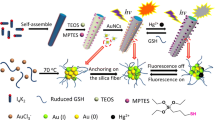Abstract
A novel benzene sulfonamide-appended silica precursor has been designed and it played dual roles. Firstly, typical green emissions derived from f–f transitions have been achieved through its complexation with terbium ions. Secondly, the hydrolysis–polycondensation process that leads to new organic–inorganic hybrid material has been realized by its reactive trimethoxysilane unit. Different microstructures, controllable synthesis, and their photophysical properties were investigated. Importantly, these novel nanosystems were demonstrated to be capable of monitoring Cu2+ in terms of sharp luminescence changes.
Graphical Abstract
A novel benzene sulfonamide-appended silica precursor has been designed, and typical green emissions derived from f–f transitions have been achieved. The hydrolysis–polycondensation process that leads to new organic–inorganic hybrid material has been realized by its reactive trimethoxysilane unit. Importantly, these novel nanosystems were demonstrated to be capable of monitoring Cu2+ in terms of sharp luminescence changes.











Similar content being viewed by others
References
Cui JJ, Wang SF, Huang K, Li YS, Zhao WR, Shi JL, Gu JL (2014) New J Chem 38:6017–6024
Wei P, Bi XD, Wu Z, Xu Z (2005) Org Lett 7:3199–3202
Barnham KJ, Masters CL, Bush AI (2004) Nat Rev Drug Discovery 3:205–214
Brown DR, Kozlowski H (2004) Dalton Trans 13:1907–1917
Waggoner DJ, Bartnikas TB, Gitlin JD (1999) Neurobiol Dis 6:221–230
Viswanathan K (2012) Sens Actuators A 175:15–21
Quang DT, Kim JS (2010) Chem Rev 110:6280–6301
Safavi A, Bagheri M (2005) Sens Actuators B 107:53–58
Gholivand MB, Niroomandi P, Yari A (2005) Anal Chim Acta 538:225–231
Kim HN, Lee MH, Kim HJ, Kim JS, Yoon J (2008) Chem Soc Rev 37:1465–1480
Yeh JT, Chen WC, Liu SR, Wu SP (2014) New J Chem 38:4434–4439
Tan CL, Wang QM, Zheng YH (2010) J Rare Earths 28:888–891
Bünzli JCG, Piguet C (2005) Chem Soc Rev 34(2005):1048–1077
Lenaert P, Driesen K, Deun RV (2005) Chem Mater 17:2148–2154
Carlos LD (2009) Ferreira RASa, Bermudez VZ. Adv Mater 21:509–534
Stathatos E, Lianos P, Tsakiroglou C (2004) Microporous Mesoporous Mater 75:255–260
Sun LN, Dang S, Yu JB (2010) J Phys Chem B 114:16393–16397
Wang QM, Yan B (2004) J Mater Chem 14:2450–2454
Yan B, Lu HF (2008) Inorg Chem 47:5601–5611
Montalti M, Prodi L, Zaccheroni N (2005) J Mater Chem 15:2810–2814
Pang ST, Zhou Z, Wang QM (2013) J Nanopart Res 15:1495–1501
Goncalves MC, Bermudez VZ, Sa Ferreira RA, Carlos LD, Ostrovskii D, Rocha J (2004) Chem Mater 16:2530–2543
SaFerreira RA, Carlos LD, Goncalves RR, Ribeiro SJL, Bermudez VZ (2001) Chem Mater 13:2991–2998
Wang QM, Tan CL, Chen HY, Tamiaki H (2010) J Phys Chem C 114:13879–13883
Acknowledgments
Q. M. acknowledges the support from National Natural Science Foundation of China (Nos. 21371063; 21328503), excellent university young scholar fund of Guangdong province (Yq2013053), Guangzhou city scientific research fund (2014J4100054) and Guangdong Science and Technology plan (2013B010403025).
Author information
Authors and Affiliations
Corresponding author
Electronic supplementary material
Below is the link to the electronic supplementary material.
Rights and permissions
About this article
Cite this article
Wang, Z., Wang, Q. Two novel benzene sulfonamide-modified luminescent nanosystems and their sensing features. J Sol-Gel Sci Technol 76, 164–170 (2015). https://doi.org/10.1007/s10971-015-3763-8
Received:
Accepted:
Published:
Issue Date:
DOI: https://doi.org/10.1007/s10971-015-3763-8




